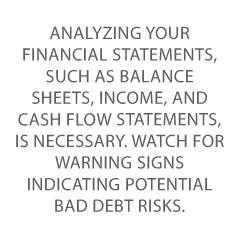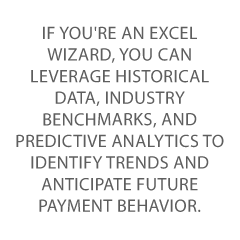Running a small business in today’s unpredictable global economic landscape is like juggling fire. Or skating on thin ice.
You get the picture. With one wrong move, everything could fall out beneath you.
That’s why creating safety nets is always wise, like forecasting and managing bad debt to prevent liquidity problems.
It’s a must-have skill for entrepreneurs and small business owners, especially as we approach uncharted economic territory with record-high inflation, regional bank failures, and heightened geopolitical tensions.
In this guide, we’ll share five essential steps for forecasting bad debt so that you can plan for cash flow, budget for potential losses, and keep your operations running smoothly.
So let’s dive in and learn how to navigate the challenges of bad debt in an increasingly volatile global economy.
This blog post may contain affiliate links, meaning when you click the links for some products and make a purchase, Credit Suite receives a commission at no additional cost to you.
What is bad debt?
Before diving into the steps to forecast bad debt, it’s important to understand what bad debt is and how it affects your business.
Bad debt occurs when a customer or client fails to meet payment obligations, resulting in an unpaid invoice or an account receivable that can’t be collected.
Not an ideal scenario. And it can happen for various reasons, including customer bankruptcy, financial distress, or fraudulent activities.
Bad debt can negatively impact your business’s cash flow and profitability, as you likely won’t recover the funds you were expecting. That’s why it’s crucial to track and manage bad debt risk: to stay in the black and ensure the long-term success of your business.
Thankfully, forecasting bad debt and implementing proactive strategies can help minimize the impact on your bottom line, which allows your business to thrive in an increasingly volatile global economy.
So let’s break down each step in more detail.
Step 1: Assess your current financial position
First things first, you need to know where you stand financially. It’s like checking your gas tank before heading on a long road trip.
 Analyzing your financial statements, such as balance sheets, income, and cash flow statements, is necessary. Watch for warning signs indicating potential bad debt risks.
Analyzing your financial statements, such as balance sheets, income, and cash flow statements, is necessary. Watch for warning signs indicating potential bad debt risks.
Here are some red flags to keep an eye on:
- Declining sales or revenues: A consistent decrease in sales or revenues may indicate that your customers face financial difficulties, which could increase bad debt risk.
- High accounts receivable turnover ratio: Your customers take longer to pay their invoices, signaling potential cash flow issues and an increased risk of bad debt.
- Rising debt-to-equity ratio: A sign that your business is becoming more reliant on borrowed funds, which may increase the risk of defaulting on loans or other financial obligations.
- Frequent late payments or payment extensions: If your customers are consistently late with payments or requesting payment extensions, this may be a sign of financial distress, increasing the likelihood of bad debt.
- Significant changes in customer credit scores: Keep an eye on your customers’ credit scores. A substantial drop in a customer’s credit score may indicate financial instability.
If you’re not a numbers person, don’t worry — plenty of tools and resources are available to help you navigate the rough financial seas. More on that in a bit.
Step 2: Review customer creditworthiness
Trust but verify. That’s the mantra when evaluating the creditworthiness of both new and existing customers.
For example, imagine you want to buy a new smartphone from Verizon, which offers a monthly payment plan. Before approving that payment plan, the store might check your credit score to ensure you have a history of paying your bills on time.
Verifying this information helps the store feel confident that you’ll make the payments and avoid a build-up of bad debt. So why not follow this same approach for your business?
You’ll sleep better at night knowing you can identify high-risk customers from the get-go and take appropriate action to minimize risk.
For high-risk customers, consider securing collateral or requiring personal guarantees to mitigate risk.
One common use case for this approach is when a landlord or property manager rents an apartment to a tenant with a poor credit history. To mitigate the risk of not receiving their monthly rent payments, they typically require the tenant to have a co-signer with a good credit score, like a family member or a friend.
The co-signer is responsible for paying if the tenant doesn’t. The result? The landlord is guaranteed to receive the rent, even if the tenant can’t afford it or stops paying altogether.
Step 3: Create a credit policy
Next up is establishing solid credit policies and procedures to manage bad debt risk. This step is all about setting the rules of the game.
Draft a concise credit policy outlining your payment terms, late fees, and consequences for non-payment, make sure it aligns with FCRA, and then communicate this policy to your customers upfront.
Example Credit Policy for XYZ Company
- Credit Terms
Standard credit terms for approved customers are net 30 days from the invoice date unless otherwise negotiated and documented in writing. In some cases, the credit department may require a deposit or prepayment before the shipment of goods or services.
- Late Payments and Collections
Payments not received within the agreed-upon terms will be considered past due. The following actions will be taken for past-due accounts:
- 1–15 days past due: The credit department will email a friendly reminder or call the customer to request payment. When it comes to emails, it’s important to set up DMARC for an extra layer of security and email authentication.
- 16–30 days past due: The credit department will send a second, more urgent reminder and may impose a late payment fee, as specified in the credit agreement.
- 31–60 days past due: The account will be placed on credit hold, and no further shipments will be made until the outstanding balance is paid. The credit department will escalate collection efforts, including sending a demand letter and contacting the customer by phone.
- Over 60 days past due: If payment is not received, the account may be referred to a collection agency, or legal action may be taken.
- Account Reviews and Credit Limit Adjustments
The credit department will periodically review customer accounts annually or more frequently for high-risk customers. Credit limits and terms may be adjusted based on changes in the customer’s payment history, financial situation, or risk profile.
- Write-Offs and Bad Debt
Bad debts will be written off when all reasonable collection efforts have been exhausted, and it becomes apparent that the debt is unlikely to be recovered. The finance manager must approve write-offs which will be recorded as a bad debt expense in the company’s financial statements.
- Policy Exceptions and Amendments
Any exceptions to this credit policy must be documented in writing and approved by the finance manager. This policy will be reviewed and updated as needed to ensure its continued effectiveness in different market environments and compliance with applicable laws and regulations.
Step 4: Closely watch aging accounts receivable
Keep a close eye on your accounts receivable aging report and identify any accounts that are past due or have a history of late payments.
Based on this data, you should be able to establish a run rate for potential delinquent payments.
There isn’t a single formula for calculating bad debt, as it can depend on the specific method and assumptions a business uses. However, a common way to estimate bad debt expense is by using the percentage of sales or the percentage of accounts receivable method.
Percentage of Sales Method
With this method, businesses calculate bad debt expense as a percentage of their credit sales for a given period. The percentage is typically based on historical data and adjusted for anticipated changes in customer payment behavior.
Formula: Bad Debt Expense = Total Credit Sales × Bad Debt Percentage
Percentage of Accounts Receivable Method (Aging of Accounts Receivable Method)
Businesses use this method to analyze their accounts receivable by age categories (e.g., 30 days, 60 days, 90 days, etc.). They assign different percentages of the likelihood of not being collected to each category based on historical data and trends.
Of course, a well-oiled collection process is your best friend when minimizing bad debt. The most effective collections strategies include setting clear payment expectations, sending timely reminders, and escalating delinquent accounts when necessary.
But if you’re feeling particularly overwhelmed, consider outsourcing collections to a third-party agency or using automated collections tools. Businesses can also turn over unpaid invoices to a factoring company. The most important thing is that money is coming in the door.
Step 5: Use financial forecasting tools
 If you’re an Excel wizard, you can leverage historical data, industry benchmarks, and predictive analytics to identify trends and anticipate future payment behavior.
If you’re an Excel wizard, you can leverage historical data, industry benchmarks, and predictive analytics to identify trends and anticipate future payment behavior.
Or, if you prefer to tap into the power of newer technology, you can use financial forecasting tools to estimate your bad debt expense. These automated forecasts can help you plan for cash flow, budget for potential losses, and build up an allowance for doubtful accounts (also known as a bad debt reserve).
When in doubt, consult a financial advisor or accountant to develop a plan for forecasting bad debt and managing your cash flow. They can provide key insights and help you create a plan tailored to your business needs.
When your business is at stake, asking for help never hurts. There’s always a professional willing to assist. It could make all the difference between keeping your business afloat or closing it down for good. So don’t hesitate if you’re not positive about the next move forward.
Key takeaways
Forecasting bad debt in an increasingly volatile global economy is no walk in the park. You never know what’s around the corner.
So being proactive, understanding your current financial situation, and establishing a robust credit policy will only benefit you when the economy takes a nosedive.
And never take your eyes off your accounts receivable. When your best clients (who always pay on time) start to let their invoices trickle in the last week before they are due, it’s a red flag. And something’s lurking in the shadows.
The best way forward is to leverage financial models and tools to establish a bad debt reserve when your business is flourishing. That way, you’ll stay out of the red when volatility hits.
So, embrace the challenge and take a proactive financial planning and risk management approach. The journey may be tough, but proper planning is worth it to stay afloat.
About the author
Ryan Robinson. I’m a blogger, podcaster and (recovering) side project addict that teaches 500,000 monthly readers how to start a blog and grow a profitable side business at ryrob.com.


